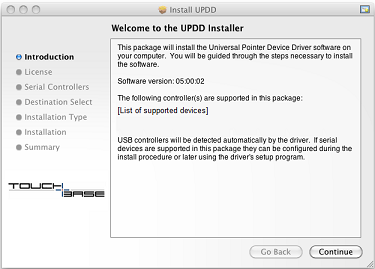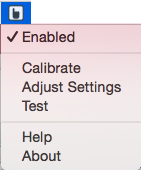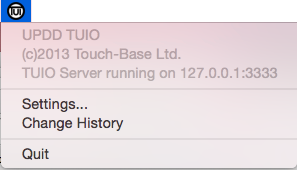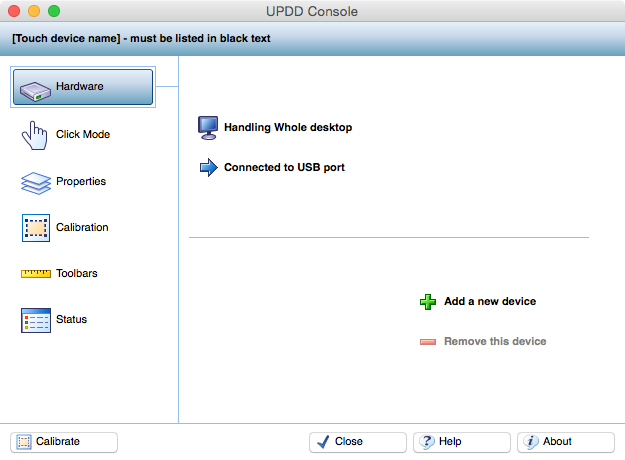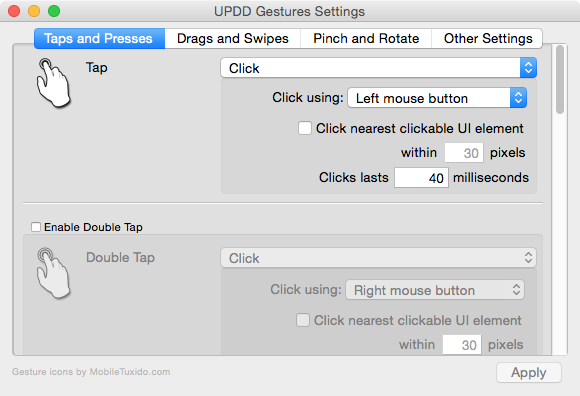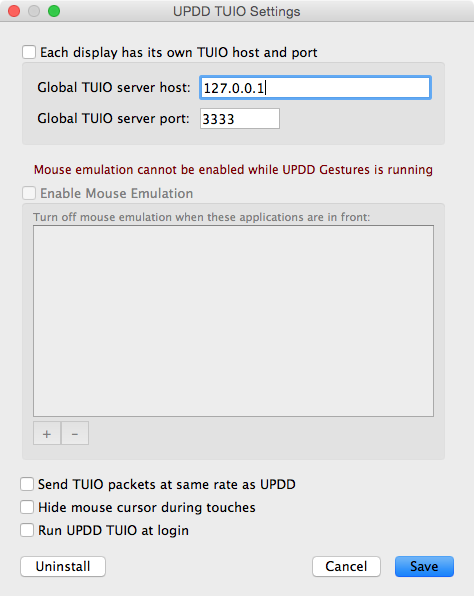UPDD Mac OS X – Quick installation guide
Last updated 10th July 2015
Welcome to the Mac OS X Quick Installation Guide which covers the key elements for installing the current UPDD Mac OS X driver. At the time of writing this driver supports Mac OS X 10:6 thro’ 10:10. We are aware of issues with both the driver and gesture software in Mac 10:11 that will are currently addressing.
The complete UPDD driver document is available here and contains comprehensive installation and usage instructions and should be referenced if installation fails or the touch screen does not function as expected and for a greater understanding of the UPDD driver software.
The software is delivered as a download link to a Mac OS X disk image container file updd.dmg. The actual name of the .dmg file reflects the version of the driver being installed, e.g.updd_05_01_1315.dmg.
The .dmg file will expand to a package file updd.pkg (this step may be invoked automatically when downloading the .dmg file).
To install the software double click on the package file and follow the instructions on the install dialog until the ‘Installation has completed’ screen is seen.
Installation
|
|
|
|
|
|
In most cases the installer will only install the touch driver and related
driver utilities but in other cases it will also install driver add-ons such as
Gestures or TUIO server. The latest gesture and TUIO software can always be
downloaded from our web site.
Following a successful install, touching the screen should move the cursor, albeit it may need calibrating for the system pointer to be accurately placed under the point of touch.
Menu Bar Items
There will be Menu Bar item for each UPDD component installed
(in some OEM installs these are disabled):

Selecting the menu bar icon will list the menu options:
|
Driver |
Gestues |
TUIO |
|
|
|
|
Utility Programs
The UPDD utilities programs are placed in the Mac’s Utilites folder. There are a number of utilities related to the driver and one each for gestures and TUIO server when they are installed (either by the driver installer or separately).
|
Driver |
Gestures |
TUIO |
|||
|
Console |
Calibration |
Test |
Uninstall |
Settings |
Settings |
|
|
|
|
|
|
|
Calibration
In most cases the touch screen will need to be calibrated with the video area. The simplest way to achieve this is to invoke the Calibration program from the Utilities folder or select Calibrate from the driver’s Menu Bar menu.
In single monitor systems the calibration screen will be shown on the monitor. Touch each calibration cross in turn as shown. In a multi-monitor system, the first time calibration is invoked, a single cross will be shown on each monitor - ESC out of any that are not the touch screen and touch the cross that appears on the touch screen monitor. The calibration screen will now be shown on the touch monitor. The UPDD Console will reflect the monitor associated with the touch screen.
System Interfaces
A number of interfaces are used to post touch data into the Mac OS X system and applications as described below:
|
Interface |
Description |
|
Driver |
The driver reads all touch data from the touch screen but only posts single touches directly into the system such that the touch screen acts like a mouse type device. All touch data received from the device is made available on the driver’s Application Programmers Interface (API). |
|
Docs |
The complete documentation is here. |
|
Settings |
The driver settings can be adjusted in the UPDD Console:
|
|
Updates |
The UPDD Console, About box shows the version in use. Contact the driver supplier for any updates. |
|
Gestures |
The gesture application receives touch data from the driver API, performs the action associated with the incoming gesture and then posts the touch data into the OS as native touch events. |
|
Docs |
The complete documentation is here. |
|
Settings |
The gesture settings can be adjusted in the gesture settings dialog:
Note –
The ‘Click nearest clickable UI element’ (as seen above) is a useful setting
to enable if you are using the touchscreen to select small buttons, such as
the minimise, maximise and close buttons in standard application dialogs |
|
Updates |
The Menu Bar menu item ‘Change History’ will show the version in use. Release notes can be found here and the latest software is available via a link in the Gesture documentation. |
|
|
|
|
TUIO |
The TUIO Server receives touch data from the driver API and posts the touch data to TUIO Client applications. This software is only required if you are running TUIO client applications. |
|
Docs |
The complete documentation is here. |
|
Settings |
The TUIO settings can be adjusted in the TUIO settings dialog:
|
|
Updates |
The Menu Bar menu item ‘Change History’ will show the version in use. Release notes can be found here and the latest software is available via a link in the TUIO documentation. |


